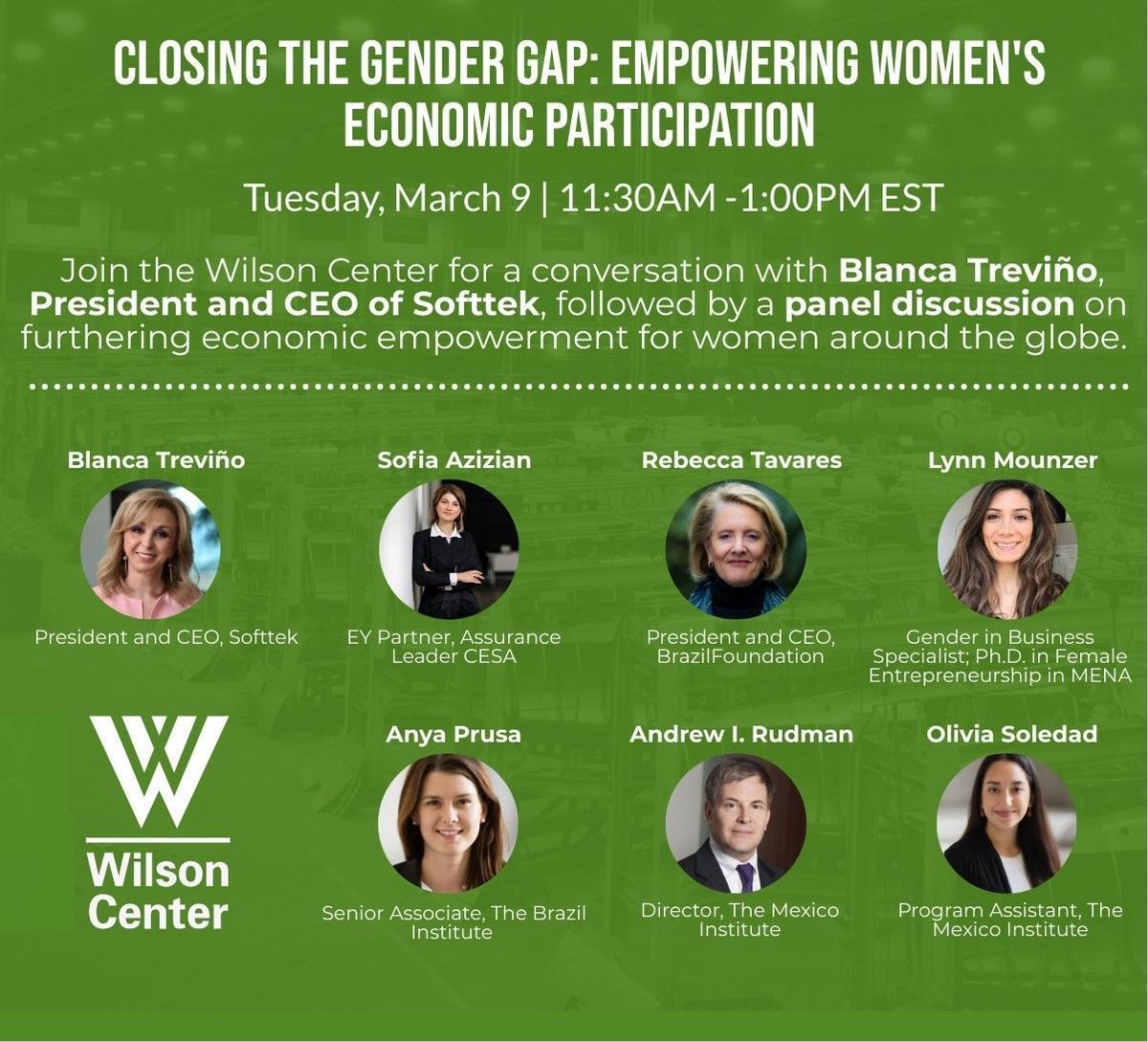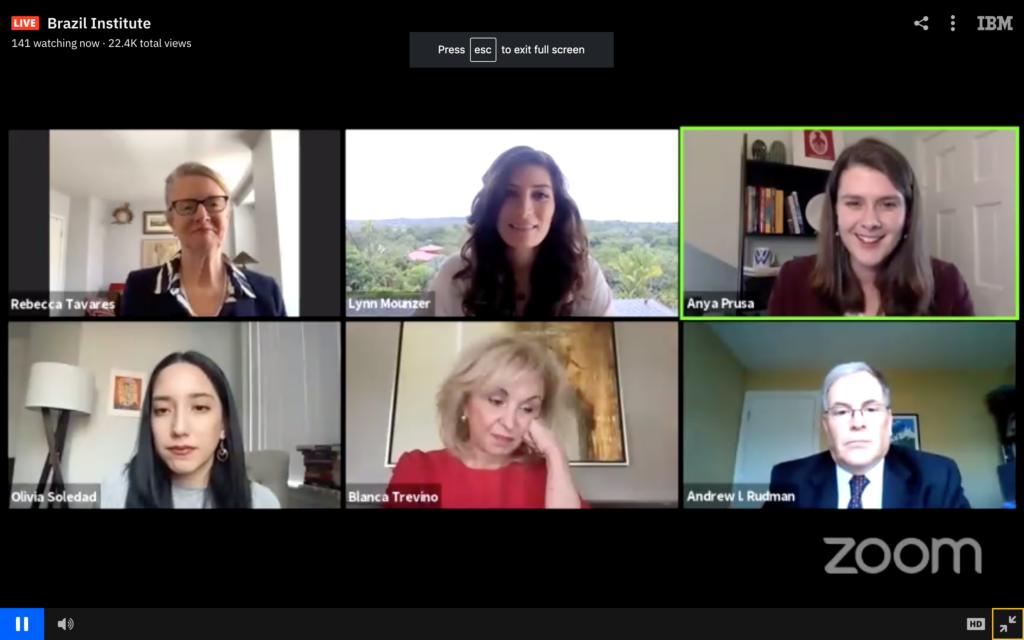“Every working woman needs a wife,” joked Sofia Azizan to the Wilson Center conversation with Blanca Trevio, Lynn Mounzer, REbecca Tavares, Anya Prusa, Andrew Rudman, and Olivia Soledad. Yesterday was International Women’s Day, and today the Wilson Center is taking stock by covering all regions.
As pointed in in #IWDATWilson Twitter chat, “We need to really examine evidence from COVID-19 on the (social) media response to women leaders during a global crisis, to address bias and make public service a safe space for the next generation of women leaders,” shares Director of the Serious Games Initiative. And we need to overlay the pandemic impact conversation on the ongoing conversation of addressing the gender gap.
Closing the Gender Gap: Empowering Women’s Economic Participation

Of course, we are monitoring the Middle East & North Africa region. So we are live-tweeting observations shared by one of the sponsors, Wilson Center Middle East Program, on the region and the impact of the pandemic on women as it intersects in the following ways:
- What defines the gender gap and deficit?
- How economic and social policies intersect women pursuing entrepreneurship?
- How does corruption impact women doing business?
- How various forms of violence affect women directly and indirectly?
- How are countries addressing the fact that women perform the majority of the world’s unpaid caregiving hours?
- Mostly women have been laid-off: Women make up 39 percent of global employment but account for 54 percent of overall job losses.
- According to this global report, “women’s jobs are 1.8 times more vulnerable to this crisis than men’s jobs.”
Metrics: Which Goal Posts Needed?
- Holding private company leadership to include women.
- Need to look at equitable division of labor?
- How to bring more men in leadership into these discussions?
- How to measure lowering barriers to entry?
- What incentives are in place for countries to update and collect relevant data?

Female Entrepreneurship in Middle East
Lynn Mounzer shares her observations as a specialist in gender.
- 1 in 3 startups are founded by women in Middle East (unsure if this covers North Africa)
- 7 out of 10 countries are in the lowest scores for Gender Gap, including Yemen.
- Female entrepreneurs face challenges in obtaining loans based on “discriminatory inheritance laws”,
- 700,000 women have lost their jobs during the #COVID19 pandemic.
- Women, faced with job loss, or underemployment, convert homes into service provider industries, like salons to earn income during pandemic crisis.
- Interviewed 200 women entrepreneurs in Middle East & North Africa.
- Many felt pressured to take on male business partners.
- Respondents shared that biggest challenge was ‘Corruption’.
- Felt compelled to give into bribery.
- Or did not register their businesses formally.
- Access to technology is more limited as pandemic forces more women at home. Who controls the laptop?
- Applauds the region for trying to diversify sectors to supplement oil & gas industry.
Female Political Participation
- PITAPOLICY tracks the Gender Inequality Index to partially assess female political participation.
- We are digging deeper into the “Share of Parliament Seats” index by running additional t-test across regions that fit within the same HDI category to address regional or cultural biases. For example, we will focus in on Arab and MENA regions since they do not rank in the “Very High” HDI category but vary more in their HDI scores than their GII scores.
- To address the UN data limitation of not referencing local and civic engagement, we would have to concatenate the data set to include data sources tracking number of women running for local office, holding municipal seats, and registered number of women’s organizations from a more robust data source tracking women’s empowerment, such as regional organizing councils or international nongovernmental organizations, like Vital Voices
Data is OUTDATED
- PITAPOLICY asked: What’s the Relationship of Number of Women’s Organizations in Country relative to their Female Labor Force Participation? (Data analysis and Python code here.)

- We see from our scatterplot entitled: “Number of Women’s Organizations Related to Labor Participation” that it’s not a linear relationship.
- Just because a country has a high number of women’s organizations, as indicated by the x-axis, does not mean that the labor participation rate among women, as indicated by the y-axis is higher than mean of “female labour force participation rate”, 51.56 percent.
- Countries with over 35 women’s organizations have similar participation rates as countries with less than 10 women’s organizations.
- What’s the biggest data collection challenge on #COVID19 in Eastern Mediterranean region covered by @WHOEMRO @WHOJordan @WHOEgypt?

“One challenge that WHO faced during the pandemic was insufficient resources and technical capacity for collecting, processing and modelling epidemiological data in the region.” ~Dr. Rana Hajjeh at University of Beirut: #WiDSAUB21 #WiDS2021
WC ME showcases Middle Eastern Women Leading in Business |
| In celebration of International Women’s Day… Wilson Center asked Middle East business leaders and government officials to share a “shout out” about a woman entrepreneur or business leader who inspires them:        READ FULL ARTICLECheck out Wilson Center’s new podcast, empowerME conversations , featuring discussions with business and government leaders shaping the Middle East! Season 1 included top regional entrepreneurs Nour Al Hassan and Mona Ataya. They focused on their path to success with the struggles they faced. |

